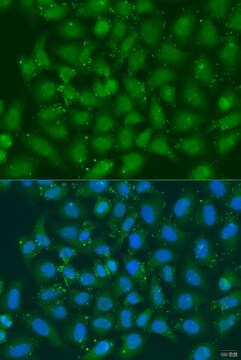推荐产品
生物源
rabbit
共軛
unconjugated
抗體表格
affinity isolated antibody
抗體產品種類
primary antibodies
無性繁殖
polyclonal
產品線
Prestige Antibodies® Powered by Atlas Antibodies
形狀
buffered aqueous glycerol solution
物種活性
human
加強驗證
recombinant expression
Learn more about Antibody Enhanced Validation
技術
immunoblotting: 0.04-0.4 μg/mL
immunofluorescence: 0.25-2 μg/mL
immunohistochemistry: 1:50-1:200
免疫原序列
EEVQEEDFVLQVAAPPSIQIKRVMTYRDLDNDLMKYSAIQTLDGEIDLKLLTKVLAPEHEVREDDVGWDWDHLFTEVSSEVLTEWDPLQTEKEDPA
運輸包裝
wet ice
儲存溫度
−20°C
目標翻譯後修改
unmodified
基因資訊
human ... C14orf179(112752)
相关类别
免疫原
intraflagellar transport 43
應用
All Prestige Antibodies Powered by Atlas Antibodies are developed and validated by the Human Protein Atlas (HPA) project and as a result, are supported by the most extensive characterization in the industry.
The Human Protein Atlas project can be subdivided into three efforts: Human Tissue Atlas, Cancer Atlas, and Human Cell Atlas. The antibodies that have been generated in support of the Tissue and Cancer Atlas projects have been tested by immunohistochemistry against hundreds of normal and disease tissues and through the recent efforts of the Human Cell Atlas project, many have been characterized by immunofluorescence to map the human proteome not only at the tissue level but now at the subcellular level. These images and the collection of this vast data set can be viewed on the Human Protein Atlas (HPA) site by clicking on the Image Gallery link. We also provide Prestige Antibodies® protocols and other useful information.
The Human Protein Atlas project can be subdivided into three efforts: Human Tissue Atlas, Cancer Atlas, and Human Cell Atlas. The antibodies that have been generated in support of the Tissue and Cancer Atlas projects have been tested by immunohistochemistry against hundreds of normal and disease tissues and through the recent efforts of the Human Cell Atlas project, many have been characterized by immunofluorescence to map the human proteome not only at the tissue level but now at the subcellular level. These images and the collection of this vast data set can be viewed on the Human Protein Atlas (HPA) site by clicking on the Image Gallery link. We also provide Prestige Antibodies® protocols and other useful information.
生化/生理作用
IFT43 is also known as CED3 and C14orf179. The gene encodes for IFT43 which is a subunit of the IFT complex A (IFT-A) machinery of primary cilia. Intraflagellar transport (IFT) is a conserved mechanism required to assemble cilia and for trafficking within cilia. The gene is associated with Cranioectodermal dysplasia (CED), a ciliopathy (also known as Sensenbrenner syndrome), which is a multi-system disorder with skeletal involvement, ectodermal features, joint laxity, growth retardation, and characteristic facial features.
特點和優勢
Prestige Antibodies® are highly characterized and extensively validated antibodies with the added benefit of all available characterization data for each target being accessible via the Human Protein Atlas portal linked just below the product name at the top of this page. The uniqueness and low cross-reactivity of the Prestige Antibodies® to other proteins are due to a thorough selection of antigen regions, affinity purification, and stringent selection. Prestige antigen controls are available for every corresponding Prestige Antibody and can be found in the linkage section.
Every Prestige Antibody is tested in the following ways:
Every Prestige Antibody is tested in the following ways:
- IHC tissue array of 44 normal human tissues and 20 of the most common cancer type tissues.
- Protein array of 364 human recombinant protein fragments.
聯結
Corresponding Antigen APREST70660
外觀
Solution in phosphate-buffered saline, pH 7.2, containing 40% glycerol and 0.02% sodium azide
法律資訊
Prestige Antibodies is a registered trademark of Merck KGaA, Darmstadt, Germany
免責聲明
Unless otherwise stated in our catalog or other company documentation accompanying the product(s), our products are intended for research use only and are not to be used for any other purpose, which includes but is not limited to, unauthorized commercial uses, in vitro diagnostic uses, ex vivo or in vivo therapeutic uses or any type of consumption or application to humans or animals.
未找到合适的产品?
试试我们的产品选型工具.
儲存類別代碼
10 - Combustible liquids
水污染物質分類(WGK)
WGK 1
閃點(°F)
Not applicable
閃點(°C)
Not applicable
個人防護裝備
Eyeshields, Gloves, multi-purpose combination respirator cartridge (US)
Margaret P Adam et al.
GeneReviews(?), 2013 Sep 12 (2013-09-13)
Cranioectodermal dysplasia (CED), a ciliopathy also known as Sensenbrenner syndrome, is a multi-system disorder with skeletal involvement (narrow thorax, shortened proximal limbs, and brachydactyly), ectodermal features (widely-spaced hypoplastic teeth, hypodontia, sparse hair, skin laxity, abnormal nails), joint laxity, growth retardation
Heleen H Arts et al.
Journal of medical genetics, 48(6), 390-395 (2011-03-08)
Sensenbrenner syndrome is a heterogeneous ciliopathy that is characterised by skeletal and ectodermal anomalies, accompanied by chronic renal failure, heart defects, liver fibrosis and other features. To identify an additional causative gene in Sensenbrenner syndrome. Single nucleotide polymorphism array analysis
Saikat Mukhopadhyay et al.
Genes & development, 24(19), 2180-2193 (2010-10-05)
Primary cilia function as a sensory signaling compartment in processes ranging from mammalian Hedgehog signaling to neuronal control of obesity. Intraflagellar transport (IFT) is an ancient, conserved mechanism required to assemble cilia and for trafficking within cilia. The link between
Priya R Gupta et al.
Human molecular genetics, 27(11), 2012-2024 (2018-04-17)
Intraflagellar transport (IFT) is a bidirectional transport process that occurs along primary cilia and specialized sensory cilia, such as photoreceptor outersegments. Genes coding for various IFT components are associated with ciliopathies. Mutations in IFT172 lead to diseases ranging from isolated
Laura Vuolo et al.
eLife, 7 (2018-10-16)
The dynein-2 microtubule motor is the retrograde motor for intraflagellar transport. Mutations in dynein-2 components cause skeletal ciliopathies, notably Jeune syndrome. Dynein-2 contains a heterodimer of two non-identical intermediate chains, WDR34 and WDR60. Here, we use knockout cell lines to
我们的科学家团队拥有各种研究领域经验,包括生命科学、材料科学、化学合成、色谱、分析及许多其他领域.
联系技术服务部门









